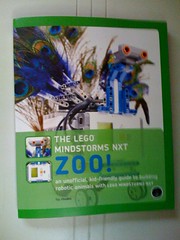
 There’s a long and noble tradition of creating robots that mimic animal life. When Mark Tilden invented BEAM robotics, part of his thought was to have the bots emulate natural organisms — the "B" in BEAM even stands for Biology. While LEGO Mindstorms contains components far more sophisticated than any of those old BEAM bots, all amateur robotics kids owe at least a nod to that pioneering mindset.
There’s a long and noble tradition of creating robots that mimic animal life. When Mark Tilden invented BEAM robotics, part of his thought was to have the bots emulate natural organisms — the "B" in BEAM even stands for Biology. While LEGO Mindstorms contains components far more sophisticated than any of those old BEAM bots, all amateur robotics kids owe at least a nod to that pioneering mindset.
So it shouldn’t come as a surprise to see books like The LEGO MINDSTORMS NXT Zoo!: A Kid-Friendly Guide to Building Animals with the NXT Robotics System (No Starch) embrace the animal theme. Written by Fay Rhodes as an answer to ultra-competetive techno-bots, the book explores creating Mindstorms animals from a kid’s viewpoint, emulating the natural movements of wildlife. Certainly, there have been plenty of Mindstorms animals in the past — for instance, the scorpion in the basic Mindstorms set — but Ms. Rhodes’ creations stand out for their creativity and fun.
She starts off simple with a couple of hoppers, the frog and rabbit.
These are models that use those rubber fingertip protectors as traction. Incidentally, their claim to fame is that they are the first
NXT robots to move by hopping. The next project, the camel, walks along on four legs with a touch sensor serving as the head. The spider model is next, scurrying on eight legs and using the ultrasonic sensor to avoid obstacles. The mouth-snapping gator follows, along with a spike-backed dinosaur and an elephant. My favorite two models come last
– a skunk, which rather than spraying offenders with musk, shoots a dart out of its butt! And finally the peacock, shown in the video clip above, which is just simply a lovely and original idea.
In addition to model CADs and beginner-focused instructions, Rhodes tutors users on the basics of NXT-G, the Mindstroms programming language. She also provides a great deal of troubleshooting info for each robot, including programming foibles and gear-fu. There’s even a teachers’ appendix offering classroom tips.
My main quibble with the book — and Ms. Rhodes addresses this in the introduction — is that every project described inside requires additional Technic parts not found in the main Mindstorms NXT set or else non-LEGO parts like fishing line. Other NXT books go out of their way to minimize the "parts curve" for beginning builders. For instance,
David J. Perdue, author of The Unofficial LEGO MINDSTORMS NXT Inventor’s Guide specifically assures readers that all of his models could be built with the basic set alone. There I was, with a Mindstorms set, not able to build any of Ms. Rhodes’ creations. I don’t say that to reduce the value of the book, only to warn potential builders they’ll probably have to buy more parts. To her credit, the author lists parts substitutions with every model, and outlines where to find the more unusual pieces.
Mostly, however, the parts aspect wasn’t a big stumbling block for me in terms of enjoying the book. A lot of the value of references like this are the inspiration value, the programming tips and other suggestions. Even if you never build a single one of these models, you’ll get a lot out of the book.


